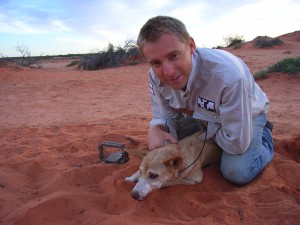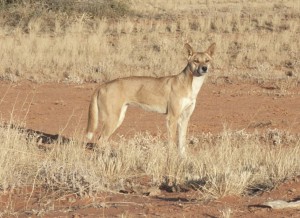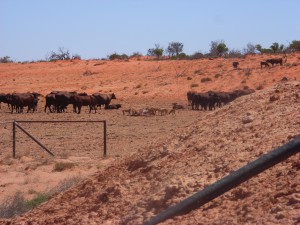
Guest post by: Benjamin Allen, University of Queensland & Robert Wicks Pest Animal Research Centre, Biosecurity Queensland, Australia.
Trophic cascades are an ecological chain reaction, where changes to one organism flow through the food chain and indirectly influence many other organisms. The study of trophic cascades has become very popular in the last few decades. Ecological theory now predicts that where and when large carnivores, top-predators or apex predators (such as lions, wolves or sharks) are removed, smaller predator and herbivore populations increase, putting increased pressure on plants and animals further down the food chain. In short, top-predator removal = biodiversity decline. This has led to calls for cessation of top-predator control globally, which is often practiced to protect livestock and manage game from predation in many parts of the world.
In Australia, dingoes (mean adult body weight = 16 kg) are the largest terrestrial predator, and invasive red foxes and feral cats are the two most ubiquitous vertebrate pests, introduced with Europeans a couple of hundred years ago. All three predators are very common and are distributed across most of the continent. However, dingoes are often controlled with poison-baits in many areas to protect sheep, goats and cattle from dingo predation.

Poison-baiting programs for dingoes are characterised by the patchy distribution of small meat or manufactured baits once or twice a year across a wider mosaic of baited and unbaited areas. About two-thirds of Australia has been baited in this way at least once in the last 10 years.
Given trophic cascade theory, some people might have been led to believe that poison-baiting programs intended for dingoes indirectly harm wildlife populations by releasing foxes and feral cats from suppression by dingoes. But this is not true, and the reason why is actually quite simple.
New research published today in Frontiers in Zoology confirms that both predator and prey populations living in areas regularly exposed to dingo control do just as well, if not better, than nearby areas where dingoes are left untouched.
This follows on from a series of associated research in Environmental Science and Pollution Research, Biological Invasions, PLOS ONE, Ecological Management & Restoration, and earlier reports also in Frontiers in Zoology.
Collectively, these reports show two things. First, there is a chronic absence of reliable evidence for dingo control-induced wildlife declines and mesopredator releases. Second, there is a large growing body of demonstrable experimental evidence of absence for these processes. Dingo control-induced declines of wildlife just don’t happen.
Why not? Because contemporary dingo control programs in the beef-cattle rangelands of Australia don’t actually reduce dingo populations to levels low enough or long enough in order for other mesopredators (such as foxes and feral cats) to exploit the situation and increase predation pressure on native wildlife. Dingo baiting does not lead to dingo removal, so the theorised chain reaction does not start.

Ultimately, dingo control programs in these systems are somewhat of an ecological non-event, for wildlife, mesopredators, and even for dingoes.
These results come from a series of large-scale and long-term experiments conducted at nine sites across the Australian rangelands since the 1990s. This is not only one of the largest predator manipulation experiments conducted anywhere in the world, but the only true research on this topic conducted in Australia. Experimental research of this kind trumps anything to the contrary that comes from the snap-shot, observational or desktop studies that characterise previous research on this topic.
The results have two important implications for people managing dingoes and wildlife in the Australian rangelands.
Dingo control can be compatible with biodiversity conservation, where distributing poison-baits to protect cattle from dingoes does not compromise native fauna conservation programs. But before people get too carried away thinking that they can distribute poison baits without consequence, we should also recognise that baiting dingoes is not permanently reducing dingo populations either. So why still do it?
If the efficacy of dingo baiting is measured in terms of removing dingoes, then we’re clearly failing. But robust measures of baiting efficacy require more than counting bodies, baits or participants. There needs to be a greater focus on managing dingo impacts, such as ‘livestock damage reduction’ or ‘risk mitigation’, because efforts to ‘reduce or remove dingoes’ clearly aren’t working and can sometimes make the situation worse.
The new Frontiers in Zoology results are reassuring, but come with one very important and intuitive condition. Top-predator control practices are unlikely to cause trophic cascades when the control practices themselves do not actually remove top-predators or alter their ecological function. But when top-predators are actually affected by control, then we might see the ecological consequences predicted. Thankfully, this is unlikely to ever happen across most of Australia.
Latest posts by Guest (see all)
- Microbial forensics: It’s not just fingerprints that can be left behind - 12th May 2015
- How can ‘conservation genomics’ help the recovery of the most endangered species? - 12th December 2014
- Acetate helps hypoxic cancer cells get fat - 11th December 2014
2 Comments